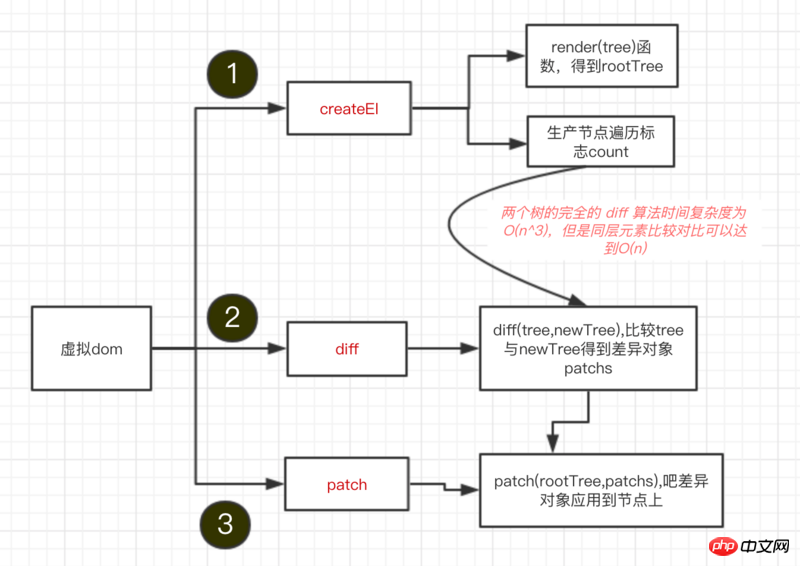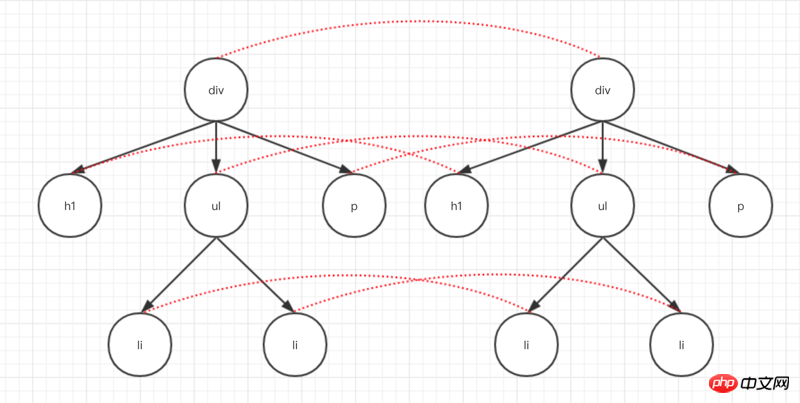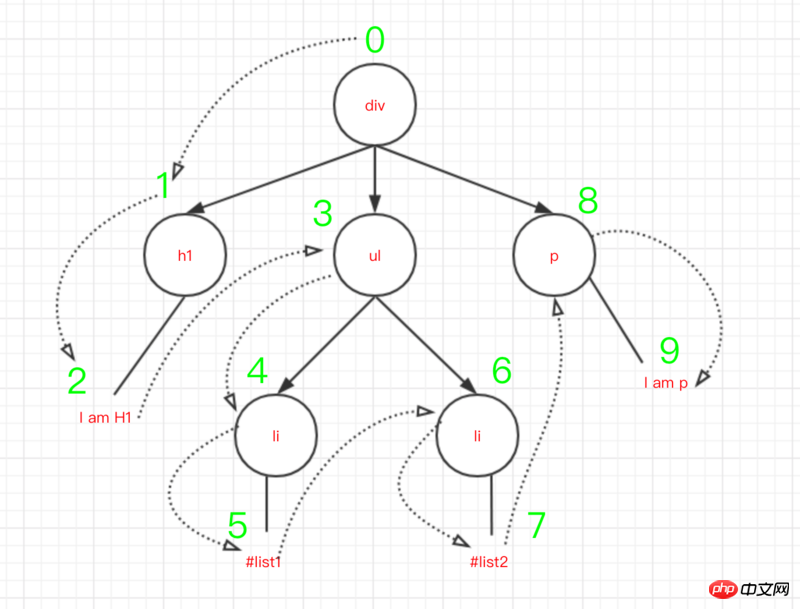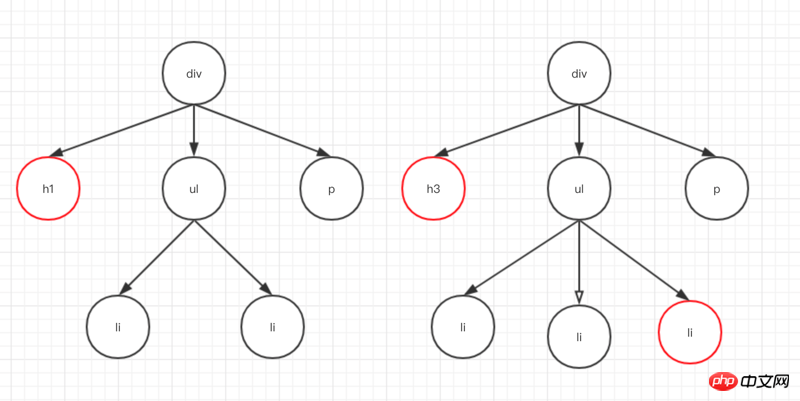虚拟dom原理流程的分析与实现
本篇文章给大家带来的内容是关于虚拟dom原理流程的分析与实现,有一定的参考价值,有需要的朋友可以参考一下,希望对你有所帮助。
背景
大家都知道,在网页中浏览器资源开销最大便是DOM节点了,DOM很慢并且非常庞大,网页性能问题大多数都是有JavaScript修改DOM所引起的。我们使用Javascript来操纵DOM,操作效率往往很低,由于DOM被表示为树结构,每次DOM中的某些内容都会发生变化,因此对DOM的更改非常快,但更改后的元素,并且它的子项必须经过Reflow / Layout阶段,然后浏览器必须重新绘制更改,这很慢的。因此,回流/重绘的次数越多,您的应用程序就越卡顿。但是,Javascript运行速度很快,虚拟DOM是放在JS 和 HTML中间的一个层。它可以通过新旧DOM的对比,来获取对比之后的差异对象,然后有针对性的把差异部分真正地渲染到页面上,从而减少实际DOM操作,最终达到性能优化的目的。
虚拟dom原理流程
简单概括有三点:
用JavaScript模拟DOM树,并渲染这个DOM树
比较新老DOM树,得到比较的差异对象
把差异对象应用到渲染的DOM树。
下面是流程图:

下面我们用代码一步步去实现一个流程图
用JavaScript模拟DOM树并渲染到页面上
其实虚拟DOM,就是用JS对象结构的一种映射,下面我们一步步实现这个过程。
我们用JS很容易模拟一个DOM树的结构,例如用这样的一个函数createEl(tagName, props, children)来创建DOM结构。
tagName标签名、props是属性的对象、children是子节点。
然后渲染到页面上,代码如下:
const createEl = (tagName, props, children) => new CreactEl(tagName, props, children)
const vdom = createEl('p', { 'id': 'box' }, [
createEl('h1', { style: 'color: pink' }, ['I am H1']),
createEl('ul', {class: 'list'}, [createEl('li', ['#list1']), createEl('li', ['#list2'])]),
createEl('p', ['I am p'])
])
const rootnode = vdom.render()
document.body.appendChild(rootnode)通过上面的函数,调用vdom.render()这样子我们就很好的构建了如下所示的一个DOM树,然后渲染到页面上
<div id="box">
<h1 style="color: pink;">I am H1</h1>
<ul class="list">
<li>#list1</li>
<li>#list2</li>
</ul>
<p>I am p</p>
</div>下面我们看看CreactEl.js代码流程:
import { setAttr } from './utils'
class CreateEl {
constructor (tagName, props, children) {
// 当只有两个参数的时候 例如 celement(el, [123])
if (Array.isArray(props)) {
children = props
props = {}
}
// tagName, props, children数据保存到this对象上
this.tagName = tagName
this.props = props || {}
this.children = children || []
this.key = props ? props.key : undefined
let count = 0
this.children.forEach(child => {
if (child instanceof CreateEl) {
count += child.count
} else {
child = '' + child
}
count++
})
// 给每一个节点设置一个count
this.count = count
}
// 构建一个 dom 树
render () {
// 创建dom
const el = document.createElement(this.tagName)
const props = this.props
// 循环所有属性,然后设置属性
for (let [key, val] of Object.entries(props)) {
setAttr(el, key, val)
}
this.children.forEach(child => {
// 递归循环 构建tree
let childEl = (child instanceof CreateEl) ? child.render() : document.createTextNode(child)
el.appendChild(childEl)
})
return el
}
}上面render函数的功能是把节点创建好,然后设置节点属性,最后递归创建。这样子我们就得到一个DOM树,然后插入(appendChild)到页面上。
比较新老dom树,得到比较的差异对象
上面,我们已经创建了一个DOM树,然后在创建一个不同的DOM树,然后做比较,得到比较的差异对象。
比较两棵DOM树的差异,是虚拟DOM的最核心部分,这也是人们常说的虚拟DOM的diff算法,两颗完全的树差异比较一个时间复杂度为 O(n^3)。但是在我们的web中很少用到跨层级DOM树的比较,所以一个层级跟一个层级对比,这样算法复杂度就可以达到 O(n)。如下图

其实在代码中,我们会从根节点开始标志遍历,遍历的时候把每个节点的差异(包括文本不同,属性不同,节点不同)记录保存起来。如下图:

两个节点之间的差异有总结起来有下面4种
0 直接替换原有节点 1 调整子节点,包括移动、删除等 2 修改节点属性 3 修改节点文本内容
如下面两棵树比较,把差异记录下来。

主要是简历一个遍历index(看图3),然后从根节点开始比较,比较万之后记录差异对象,继续从左子树比较,记录差异,一直遍历下去。主要流程如下
// 这是比较两个树找到最小移动量的算法是Levenshtein距离,即O(n * m)
// 具体请看 https://www.npmjs.com/package/list-diff2
import listDiff from 'list-diff2'
// 比较两棵树
function diff (oldTree, newTree) {
// 节点的遍历顺序
let index = 0
// 在遍历过程中记录节点的差异
let patches = {}
// 深度优先遍历两棵树
deepTraversal(oldTree, newTree, index, patches)
// 得到的差异对象返回出去
return patches
}
function deepTraversal(oldNode, newNode, index, patches) {
let currentPatch = []
// ...中间有很多对patches的处理
// 递归比较子节点是否相同
diffChildren(oldNode.children, newNode.children, index, patches, currentPatch)
if (currentPatch.length) {
// 那个index节点的差异记录下来
patches[index] = currentPatch
}
}
// 子数的diff
function diffChildren (oldChildren, newChildren, index, patches, currentPatch) {
const diffs = listDiff(oldChildren, newChildren)
newChildren = diffs.children
// ...省略记录差异对象
let leftNode = null
let currentNodeIndex = index
oldChildren.forEach((child, i) => {
const newChild = newChildren[i]
// index相加
currentNodeIndex = (leftNode && leftNode.count) ? currentNodeIndex + leftNode.count + 1 : currentNodeIndex + 1
// 深度遍历,递归
deepTraversal(child, newChild, currentNodeIndex, patches)
// 从左树开始
leftNode = child
})
}然后我们调用完diff(tree, newTree)等到最后的差异对象是这样子的。
{
"1": [
{
"type": 0,
"node": {
"tagName": "h3",
"props": {
"style": "color: green"
},
"children": [
"I am H1"
],
"count": 1
}
}
]
...
}key是代表那个节点,这里我们是第二个,也就是h1会改变成h3,还有省略的两个差异对象代码没有贴出来~~
然后看下diff.js的完整代码,如下
import listDiff from 'list-diff2'
// 每个节点有四种变动
export const REPLACE = 0 // 替换原有节点
export const REORDER = 1 // 调整子节点,包括移动、删除等
export const PROPS = 2 // 修改节点属性
export const TEXT = 3 // 修改节点文本内容
export function diff (oldTree, newTree) {
// 节点的遍历顺序
let index = 0
// 在遍历过程中记录节点的差异
let patches = {}
// 深度优先遍历两棵树
deepTraversal(oldTree, newTree, index, patches)
// 得到的差异对象返回出去
return patches
}
function deepTraversal(oldNode, newNode, index, patches) {
let currentPatch = []
if (newNode === null) { // 如果新节点没有的话直接不用比较了
return
}
if (typeof oldNode === 'string' && typeof newNode === 'string') {
// 比较文本节点
if (oldNode !== newNode) {
currentPatch.push({
type: TEXT,
content: newNode
})
}
} else if (oldNode.tagName === newNode.tagName && oldNode.key === newNode.key) {
// 节点类型相同
// 比较节点的属性是否相同
let propasPatches = diffProps(oldNode, newNode)
if (propasPatches) {
currentPatch.push({
type: PROPS,
props: propsPatches
})
}
// 递归比较子节点是否相同
diffChildren(oldNode.children, newNode.children, index, patches, currentPatch)
} else {
// 节点不一样,直接替换
currentPatch.push({ type: REPLACE, node: newNode })
}
if (currentPatch.length) {
// 那个index节点的差异记录下来
patches[index] = currentPatch
}
}
// 子数的diff
function diffChildren (oldChildren, newChildren, index, patches, currentPatch) {
var diffs = listDiff(oldChildren, newChildren)
newChildren = diffs.children
// 如果调整子节点,包括移动、删除等的话
if (diffs.moves.length) {
var reorderPatch = {
type: REORDER,
moves: diffs.moves
}
currentPatch.push(reorderPatch)
}
var leftNode = null
var currentNodeIndex = index
oldChildren.forEach((child, i) => {
var newChild = newChildren[i]
// index相加
currentNodeIndex = (leftNode && leftNode.count) ? currentNodeIndex + leftNode.count + 1 : currentNodeIndex + 1
// 深度遍历,从左树开始
deepTraversal(child, newChild, currentNodeIndex, patches)
// 从左树开始
leftNode = child
})
}
// 记录属性的差异
function diffProps (oldNode, newNode) {
let count = 0 // 声明一个有没没有属性变更的标志
const oldProps = oldNode.props
const newProps = newNode.props
const propsPatches = {}
// 找出不同的属性
for (let [key, val] of Object.entries(oldProps)) {
// 新的不等于旧的
if (newProps[key] !== val) {
count++
propsPatches[key] = newProps[key]
}
}
// 找出新增的属性
for (let [key, val] of Object.entries(newProps)) {
if (!oldProps.hasOwnProperty(key)) {
count++
propsPatches[key] = val
}
}
// 没有新增 也没有不同的属性 直接返回null
if (count === 0) {
return null
}
return propsPatches
}得到差异对象之后,剩下就是把差异对象应用到我们的dom节点上面了。
把差异对象应用到渲染的dom树
到了这里其实就简单多了。我们上面得到的差异对象之后,然后选择同样的深度遍历,如果那个节点有差异的话,判断是上面4种中的哪一种,根据差异对象直接修改这个节点就可以了。
function patch (node, patches) {
// 也是从0开始
const step = {
index: 0
}
// 深度遍历
deepTraversal(node, step, patches)
}
// 深度优先遍历dom结构
function deepTraversal(node, step, patches) {
// 拿到当前差异对象
const currentPatches = patches[step.index]
const len = node.childNodes ? node.childNodes.length : 0
for (let i = 0; i < len; i++) {
const child = node.childNodes[i]
step.index++
deepTraversal(child, step, patches)
}
//如果当前节点存在差异
if (currentPatches) {
// 把差异对象应用到当前节点上
applyPatches(node, currentPatches)
}
}这样子,调用patch(rootnode, patches)就直接有针对性的改变有差异的节点了。
path.js完整代码如下:
import {REPLACE, REORDER, PROPS, TEXT} from './diff'
import { setAttr } from './utils'
export function patch (node, patches) {
// 也是从0开始
const step = {
index: 0
}
// 深度遍历
deepTraversal(node, step, patches)
}
// 深度优先遍历dom结构
function deepTraversal(node, step, patches) {
// 拿到当前差异对象
const currentPatches = patches[step.index]
const len = node.childNodes ? node.childNodes.length : 0
for (let i = 0; i < len; i++) {
const child = node.childNodes[i]
step.index++
deepTraversal(child, step, patches)
}
//如果当前节点存在差异
if (currentPatches) {
// 把差异对象应用到当前节点上
applyPatches(node, currentPatches)
}
}
// 把差异对象应用到当前节点上
function applyPatches(node, currentPatches) {
currentPatches.forEach(currentPatch => {
switch (currentPatch.type) {
// 0: 替换原有节点
case REPLACE:
var newNode = (typeof currentPatch.node === 'string') ? document.createTextNode(currentPatch.node) : currentPatch.node.render()
node.parentNode.replaceChild(newNode, node)
break
// 1: 调整子节点,包括移动、删除等
case REORDER:
moveChildren(node, currentPatch.moves)
break
// 2: 修改节点属性
case PROPS:
for (let [key, val] of Object.entries(currentPatch.props)) {
if (val === undefined) {
node.removeAttribute(key)
} else {
setAttr(node, key, val)
}
}
break;
// 3:修改节点文本内容
case TEXT:
if (node.textContent) {
node.textContent = currentPatch.content
} else {
node.nodeValue = currentPatch.content
}
break;
default:
throw new Error('Unknow patch type ' + currentPatch.type);
}
})
}
// 调整子节点,包括移动、删除等
function moveChildren (node, moves) {
let staticNodelist = Array.from(node.childNodes)
const maps = {}
staticNodelist.forEach(node => {
if (node.nodeType === 1) {
const key = node.getAttribute('key')
if (key) {
maps[key] = node
}
}
})
moves.forEach(move => {
const index = move.index
if (move.type === 0) { // 变动类型为删除的节点
if (staticNodeList[index] === node.childNodes[index]) {
node.removeChild(node.childNodes[index]);
}
staticNodeList.splice(index, 1);
} else {
let insertNode = maps[move.item.key]
? maps[move.item.key] : (typeof move.item === 'object')
? move.item.render() : document.createTextNode(move.item)
staticNodelist.splice(index, 0, insertNode);
node.insertBefore(insertNode, node.childNodes[index] || null)
}
})
}到这里,最基本的虚拟DOM原理已经讲完了,也简单了实现了一个虚拟DOM.
以上是虚拟dom原理流程的分析与实现的详细内容。更多信息请关注PHP中文网其他相关文章!

热AI工具

Undresser.AI Undress
人工智能驱动的应用程序,用于创建逼真的裸体照片

AI Clothes Remover
用于从照片中去除衣服的在线人工智能工具。

Undress AI Tool
免费脱衣服图片

Clothoff.io
AI脱衣机

Video Face Swap
使用我们完全免费的人工智能换脸工具轻松在任何视频中换脸!

热门文章

热工具

记事本++7.3.1
好用且免费的代码编辑器

SublimeText3汉化版
中文版,非常好用

禅工作室 13.0.1
功能强大的PHP集成开发环境

Dreamweaver CS6
视觉化网页开发工具

SublimeText3 Mac版
神级代码编辑软件(SublimeText3)

热门话题
 7648
7648
 15
15
 1392
1392
 52
52
 91
91
 11
11
 73
73
 19
19
 36
36
 110
110
 如何使用WebSocket和JavaScript实现在线语音识别系统
Dec 17, 2023 pm 02:54 PM
如何使用WebSocket和JavaScript实现在线语音识别系统
Dec 17, 2023 pm 02:54 PM
如何使用WebSocket和JavaScript实现在线语音识别系统引言:随着科技的不断发展,语音识别技术已经成为了人工智能领域的重要组成部分。而基于WebSocket和JavaScript实现的在线语音识别系统,具备了低延迟、实时性和跨平台的特点,成为了一种被广泛应用的解决方案。本文将介绍如何使用WebSocket和JavaScript来实现在线语音识别系
 WebSocket与JavaScript:实现实时监控系统的关键技术
Dec 17, 2023 pm 05:30 PM
WebSocket与JavaScript:实现实时监控系统的关键技术
Dec 17, 2023 pm 05:30 PM
WebSocket与JavaScript:实现实时监控系统的关键技术引言:随着互联网技术的快速发展,实时监控系统在各个领域中得到了广泛的应用。而实现实时监控的关键技术之一就是WebSocket与JavaScript的结合使用。本文将介绍WebSocket与JavaScript在实时监控系统中的应用,并给出代码示例,详细解释其实现原理。一、WebSocket技
 如何利用JavaScript和WebSocket实现实时在线点餐系统
Dec 17, 2023 pm 12:09 PM
如何利用JavaScript和WebSocket实现实时在线点餐系统
Dec 17, 2023 pm 12:09 PM
如何利用JavaScript和WebSocket实现实时在线点餐系统介绍:随着互联网的普及和技术的进步,越来越多的餐厅开始提供在线点餐服务。为了实现实时在线点餐系统,我们可以利用JavaScript和WebSocket技术。WebSocket是一种基于TCP协议的全双工通信协议,可以实现客户端与服务器的实时双向通信。在实时在线点餐系统中,当用户选择菜品并下单
 如何使用WebSocket和JavaScript实现在线预约系统
Dec 17, 2023 am 09:39 AM
如何使用WebSocket和JavaScript实现在线预约系统
Dec 17, 2023 am 09:39 AM
如何使用WebSocket和JavaScript实现在线预约系统在当今数字化的时代,越来越多的业务和服务都需要提供在线预约功能。而实现一个高效、实时的在线预约系统是至关重要的。本文将介绍如何使用WebSocket和JavaScript来实现一个在线预约系统,并提供具体的代码示例。一、什么是WebSocketWebSocket是一种在单个TCP连接上进行全双工
 JavaScript和WebSocket:打造高效的实时天气预报系统
Dec 17, 2023 pm 05:13 PM
JavaScript和WebSocket:打造高效的实时天气预报系统
Dec 17, 2023 pm 05:13 PM
JavaScript和WebSocket:打造高效的实时天气预报系统引言:如今,天气预报的准确性对于日常生活以及决策制定具有重要意义。随着技术的发展,我们可以通过实时获取天气数据来提供更准确可靠的天气预报。在本文中,我们将学习如何使用JavaScript和WebSocket技术,来构建一个高效的实时天气预报系统。本文将通过具体的代码示例来展示实现的过程。We
 简易JavaScript教程:获取HTTP状态码的方法
Jan 05, 2024 pm 06:08 PM
简易JavaScript教程:获取HTTP状态码的方法
Jan 05, 2024 pm 06:08 PM
JavaScript教程:如何获取HTTP状态码,需要具体代码示例前言:在Web开发中,经常会涉及到与服务器进行数据交互的场景。在与服务器进行通信时,我们经常需要获取返回的HTTP状态码来判断操作是否成功,根据不同的状态码来进行相应的处理。本篇文章将教你如何使用JavaScript获取HTTP状态码,并提供一些实用的代码示例。使用XMLHttpRequest
 javascript中如何使用insertBefore
Nov 24, 2023 am 11:56 AM
javascript中如何使用insertBefore
Nov 24, 2023 am 11:56 AM
用法:在JavaScript中,insertBefore()方法用于在DOM树中插入一个新的节点。这个方法需要两个参数:要插入的新节点和参考节点(即新节点将要被插入的位置的节点)。
 JavaScript和WebSocket:打造高效的实时图像处理系统
Dec 17, 2023 am 08:41 AM
JavaScript和WebSocket:打造高效的实时图像处理系统
Dec 17, 2023 am 08:41 AM
JavaScript是一种广泛应用于Web开发的编程语言,而WebSocket则是一种用于实时通信的网络协议。结合二者的强大功能,我们可以打造一个高效的实时图像处理系统。本文将介绍如何利用JavaScript和WebSocket来实现这个系统,并提供具体的代码示例。首先,我们需要明确实时图像处理系统的需求和目标。假设我们有一个摄像头设备,可以采集实时的图像数




